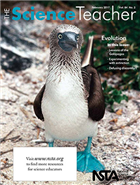Science 2.0: Developing the Computational Thinker
By sstuckey
Posted on 2017-02-23
For the past few issues, we have been focusing on the International Society for Technology in Education (ISTE) standards. This month, we look at the Computational Thinker standard. Its performance indicators require students to use technology-assisted methods to explore and find solutions; collect data, use digital tools to analyze them, and represent data in various ways; break problems into parts and develop models to facilitate problem-solving; and understand how automation works and use algorithmic thinking (ISTE 2016).
Working with data
Students need to become adept at collecting data, typically during labs in which they may be asked to fill in data tables. In co-author Ben Smith’s class, students would compile their data on spreadsheets, learning how to make calculations, graph and chart data, conduct analyses, and solve problems. Students can share data through a Google Form.
Further, students can learn how asking the right questions will lead to the data they desire. Initially, the questions could involve simple research such as the number of siblings, favorite color, height, or age. Data sets in Google Sheets can be used to analyze the class’s results and help students become more familiar with the data-manipulation tools. Questions on Google Forms can even require data validation, which ensures that each response meets the stated requirements.
Automating calculations in a spreadsheet or Google Sheet can find averages, sums, and data counts. Creating graphs, linear regressions, and histograms can help students make predictions and analyses that accompany each data set. Google Add-ons are tools that provide more functionality to the Sheets app.
Students should be able to use online tools (www.data.gov, www.opendatanetwork.com, and http://aws.amazon.com/datasets) to import a large data set into a spreadsheet for further analysis. This teaches about the importance of multiple trials involved in collecting large data sets. Teachers may have students work on a part of an experiment and then share their data with the class through a classwide Google Form.
On Google Trends, you can enter search terms that will yield results broken down by searches over time, by region, and by related queries. Students can use the tool to find when the next flu epidemic may be coming based on searched terms. When a second term is added to the query, students can see correlations between data sets. Searching the terms tsunami and earthquake, for instance, reveals a correlation between the two. To evidence their learning, students can first examine online infographics (e.g., www.kidsdiscover.com/infographics, www.livescience.com/infographics), and then use online tools to create infographics of their own (e.g., http://piktochart.com, https://www.easel.ly)
Students can use algorithmic thinking to learn to solve problems that lead to automated solutions. Ask students to map steps they will take in solving the problem. A concept mapping tool (such as LucidChart, MindMaps, or Popplet) allows students to create a flowchart or a decision tree to sequence the events needed to complete the solution. Additionally, Code.org has a number of activities that teachers and students can use to learn about algorithmic thinking.
Conclusion
The Computational Thinker can collect, present, and analyze data while working through a strategic solution.
Ben Smith (ben@edtechinnovators.com) is an educational technology program specialist, and Jared Mader (jared@edtechinnovators.com) is the director of educational technology, for the Lincoln Intermediate Unit in New Oxford, Pennsylvania. They conduct teacher workshops on technology in the classroom nationwide.
Reference
International Society for Technology in Education (ISTE). 2016. The 2016 ISTE standards for students. Arlington, VA: ISTE. http://bit.ly/ISTE-standards
Editor’s Note
This article was originally published in the February 2017 issue of The  Science Teacher journal from the National Science Teachers Association (NSTA).
Science Teacher journal from the National Science Teachers Association (NSTA).
Get Involved With NSTA!
Join NSTA today and receive The Science Teacher,
the peer-reviewed journal just for high school teachers; to write for the journal, see our Author Guidelines, Call for Papers, and annotated sample manuscript; connect on the high school level science teaching list (members can sign up on the list server); or consider joining your peers at future NSTA conferences.
Disclaimer: The views expressed in this blog post are those of the author(s) and do not necessarily reflect the official position of the National Science Teaching Association (NSTA).


